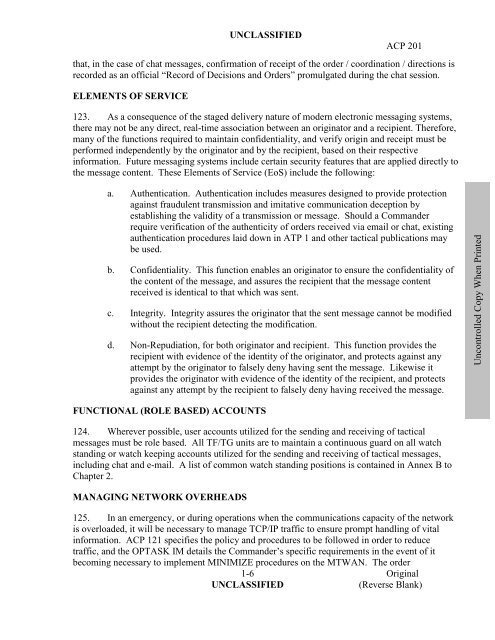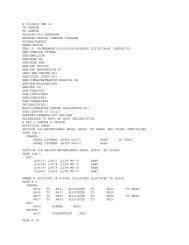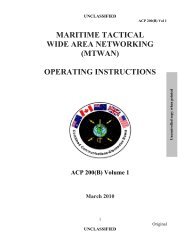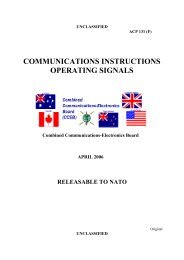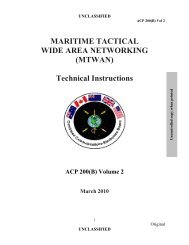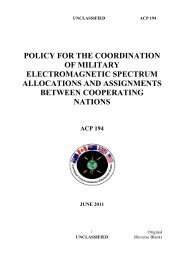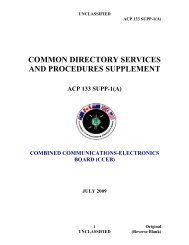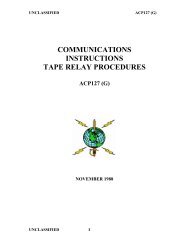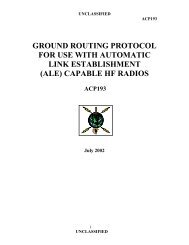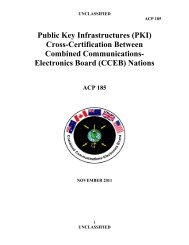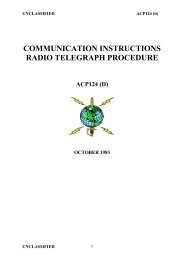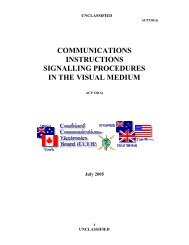ACP 201
ACP 201
ACP 201
You also want an ePaper? Increase the reach of your titles
YUMPU automatically turns print PDFs into web optimized ePapers that Google loves.
Uncontrolled Copy When Printed<br />
UNCLASSIFIED<br />
<strong>ACP</strong> <strong>201</strong><br />
that, in the case of chat messages, confirmation of receipt of the order / coordination / directions is<br />
recorded as an official ―Record of Decisions and Orders‖ promulgated during the chat session.<br />
ELEMENTS OF SERVICE<br />
123. As a consequence of the staged delivery nature of modern electronic messaging systems,<br />
there may not be any direct, real-time association between an originator and a recipient. Therefore,<br />
many of the functions required to maintain confidentiality, and verify origin and receipt must be<br />
performed independently by the originator and by the recipient, based on their respective<br />
information. Future messaging systems include certain security features that are applied directly to<br />
the message content. These Elements of Service (EoS) include the following:<br />
a. Authentication. Authentication includes measures designed to provide protection<br />
against fraudulent transmission and imitative communication deception by<br />
establishing the validity of a transmission or message. Should a Commander<br />
require verification of the authenticity of orders received via email or chat, existing<br />
authentication procedures laid down in ATP 1 and other tactical publications may<br />
be used.<br />
b. Confidentiality. This function enables an originator to ensure the confidentiality of<br />
the content of the message, and assures the recipient that the message content<br />
received is identical to that which was sent.<br />
c. Integrity. Integrity assures the originator that the sent message cannot be modified<br />
without the recipient detecting the modification.<br />
d. Non-Repudiation, for both originator and recipient. This function provides the<br />
recipient with evidence of the identity of the originator, and protects against any<br />
attempt by the originator to falsely deny having sent the message. Likewise it<br />
provides the originator with evidence of the identity of the recipient, and protects<br />
against any attempt by the recipient to falsely deny having received the message.<br />
FUNCTIONAL (ROLE BASED) ACCOUNTS<br />
124. Wherever possible, user accounts utilized for the sending and receiving of tactical<br />
messages must be role based. All TF/TG units are to maintain a continuous guard on all watch<br />
standing or watch keeping accounts utilized for the sending and receiving of tactical messages,<br />
including chat and e-mail. A list of common watch standing positions is contained in Annex B to<br />
Chapter 2.<br />
MANAGING NETWORK OVERHEADS<br />
125. In an emergency, or during operations when the communications capacity of the network<br />
is overloaded, it will be necessary to manage TCP/IP traffic to ensure prompt handling of vital<br />
information. <strong>ACP</strong> 121 specifies the policy and procedures to be followed in order to reduce<br />
traffic, and the OPTASK IM details the Commander‘s specific requirements in the event of it<br />
becoming necessary to implement MINIMIZE procedures on the MTWAN. The order<br />
1-6 Original<br />
UNCLASSIFIED<br />
(Reverse Blank)


